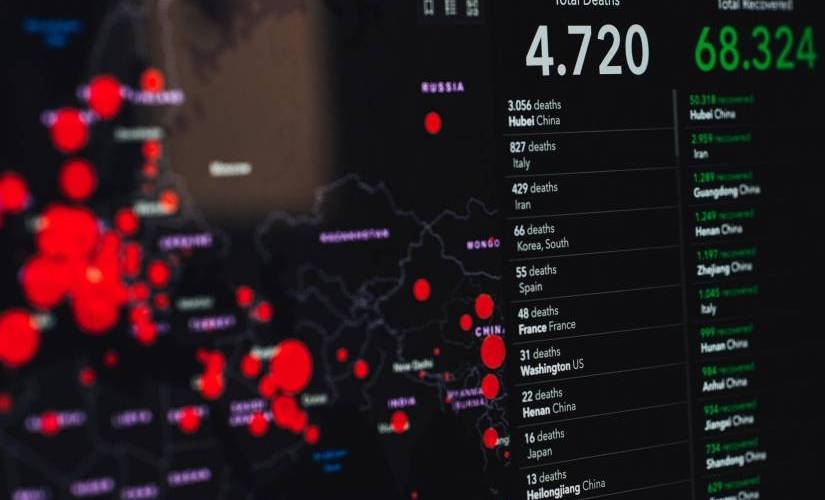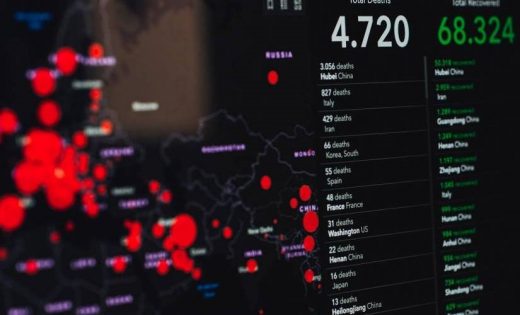Big Data as a Double-Edged Sword in the Fight Against COVID-19
Big Data as a Double-Edged Sword in the Fight Against COVID-19

Big Data has emerged as a leading technological advancement that is fueling our efforts to limit the spread of the novel coronavirus. At the time of writing, the world has seen 2,585,197 cases of COVID-19, and many countries are still waiting to hit their peak. Here is how big data as a double-edged sword in the fight against COVID-19.
In such times, the efforts on the technological front to develop platforms to reduce its effects are ongoing with advancements in drug discovery, surveillance, and tracking and tracing technologies. Tech companies and governments are spending billions of dollars on damage control and in developing Big Data and AI-powered tools to help control this situation, such as surveillance drones and contact tracing apps.
While these technologies show immense promise as a vertical to fight the spread of COVID-19, there are significant limitations and concerns that have come to light about the use of these technologies. The concern of false positives and panic concerns over privacy and security in the wake of high-tech surveillance and the use of these technologies in the post COVID world has led to a lot of raised eyebrows.
Despite this, tech giants such as Google and Apple are working in collaboration to help with contact tracing while the governments of the world, such as the US, UK, and even the European Union, are relying on such technologies to fight COVID-19.
Let’s take a look at how Big Data is being leveraged in the fight against COVID-19, the limitations of the technology, and the rising concerns with regards to its long-term use on privacy and security.
How Big Data Is being Used To Fight COVID-19
Big Data has been hailed by experts as one of the leading resources in the fight against COVID-19. Experts have found uses for Big Data and Big Data analytics platforms for various purposes, such as surveillance in Smart Cities, for contact tracing, and vaccine development.
Smart Cities For Surveillance
Within smart cities, big data platforms are being used to identify the compliance of the population with social distancing measures. Surveillance data from sensors and cameras are also being analyzed to identify pedestrian traffic within areas.
Road travel has gone down by 73% in the UK, to levels similar to those in 1955. The way smart city technology is being leveraged is going to be crucial in understanding the response of the population to government policies, and the pandemic as a whole.
It can also help narrow down the focus on specific areas using Big Data analytics where these measures are being followed with significant lethargy. The rate of spread of the virus in these areas can then be corresponded to their response, helping us better understand the impact of social distancing and lockdowns in reducing the spread of the virus.
Artificial Intelligence For Vaccine Development
The coming together of Artificial Intelligence and Big Data platforms has improved our ability to dig through years of data to identify possible drugs already approved by the FDA for treating similar viruses. These AI and Big-Data powered systems can also help identify new molecules using this database to help us develop a vaccine quicker.
This process of drug discovery is powered by modern technology is one of the reasons that illnesses today are much less fatal than they would be in the 1900s. In the case of COVID-19, similar applications of these technologies are going to be crucial to the efforts of scientists and medical experts to quickly develop and distribute vaccines.
Contact Tracing
Contact tracing has emerged as a digital solution that has been accepted universally with countries like Israel (HaMagen), Singapore (TraceTogether), and South Korea already using contact tracing platforms to locate, test, and isolate potential carriers of the novel coronavirus.
Earlier this month, Apple and Google announced a joint plan to release an API for public healthcare providers that allows contact tracing apps from public health departments to be interoperable between Android and iOS devices.
Moreover, the tech giants also announced the integration of this capability within their devices for the future to ensure wider accessibility.
Contact tracing uses BLE technology to gather encrypted identifiers from other devices in its proximity and logs it. Each app’s user can flag themselves once they are tested positive for COVID, and every person who would have come into close proximity would receive an alert. All of this action is through the encrypted proximity identifier that they might have been potentially exposed, including time and date of when they were close to a carrier.
This data can be used to identify not just potential carriers but also areas with higher virility rates, helping governments take area-specific actions by labeling them as red zones.
Limitations of Big Data
One of the limitations of Big Data and information gathering is the inability of these technologies to count for social causes. This means that while they might be great at gathering and analyzing numerical data (which isn’t necessarily true), the context of those trends being unavailable can result in poor decision-making.
For example, in poor neighborhoods, especially in developing nations, people neglecting social distancing measures can result in law enforcement agencies to take stricter measures, increase fines and, and implement stricter consequences.
While that’s one way to solve the problem, it might still be ineffective based on the initial reason for the negligence. For many people, social distancing is hard because they don’t have access to the same resources as others. Daily wage laborers are one such demographic and do not share the privilege of maintaining long-lasting social distancing, and this is something surveillance technology even within smart cities cannot account for.
So while the data available is accurate, it does not point towards a good solution, and treating all data as homogenous can be a fatal mistake that experts can make.
Secondly, critics of Big data-based platforms such as contact tracing apps highlight that the Bluetooth technology might be ineffective in understanding proximity contexts. For example, Bluetooth can be caught across walls and partitions. Even if you’re safely partitioned from a person who tests positive for COVID-19 via a wall — you’ll still get a notification for potential exposure as long as you’re in Bluetooth range.
The action allows for false positives to occur and creates unnecessary panic within the population. Demonstration the idea here — is that you cannot depend on these technologies solely and require experts to weigh in on the context of the data you’re analyzing to better come up with strategies based on that data.
Lastly, the biggest limitation of big data platforms such as a contact tracing platform Is that they have to be opt-in. The kind of user penetration it requires 60%-80% is incredibly difficult to reach for the platform to be a success. The biggest trouble here is trust. With recent debacles with regards to user data and privacy, people generally vary of such invasive platforms and might not opt-in for these services.
While Google and Apple are working on device integration, most people, in fact, don’t have access to the most recent devices, meaning that for a large portion of the population, penetration will still be a significant barrier and over-relying on these technologies can result in the negligence of other important steps such as social distancing.
Privacy Concerns With Regards To Big Data
One of the biggest reasons why Big Data is a double-edged sword is its long-term consequences. The kind of technological advancements in surveillance that are being made can have a massive impact on the world post-COVID-19.
Take, for example, of the “pandemic drones” that the US is testing that can monitor body temperature, breathing, heart-rate, coughing, and sneezing of an individual. These drones can also be used to identify people using facial recognition technology and is something right out of a dystopian novel like 1984.
That’s one end of surveillance that is more hardware-oriented. On the software end, contract tracing apps and big data platforms are being developed, which can be a huge risk of cyber threat. While Google and Apple have both promised commitment to privacy and anonymity, the tech giants of the world don’t have a great reputation with regards to upholding privacy and adopting transparent systems of accountability.
The challenge we face is the long-term use case of the innovative technologies that are being developed in the wake of COVID-19. Moreover, skeptics have raised concerns over the use of these technologies by authoritarian regimes even after COVID-19. But this skepticism can be directed towards all governments and tech companies that are involved in the development of such technologies.
Is there an expiry date for the usage of surveillance tech? To what degree will we wait for COVID-19 to slow down until we can stop violating the privacy of individuals in the way that this unprecedented crisis has forced us to do.
Conclusion
One of the things that we have to realize with regards to technological solutions and leveraging big data is that they are not perfect solutions.
Their effectivity is limited to the capability of our technological prowess, and we are yet to unlock their true potential as a race. While technological evolution has made incredible inroads towards solving this problem with multiple possible vaccines now in the human trial phase, simple things like washing hands and maintaining social distancing are incredibly crucial.
How we use technology for surveillance for potential carriers, then surveillance of those already tested positive, and in testing and drug discovery are all efforts that happen side by side fulfilling our social responsibility towards this pandemic.
However, while there’s good, the double-edged sword that is technology is also something we should be cognizant about. How this tech evolves, post-COVID is a conversation that needs to happen today before it’s too late. Privacy, security, anonymity, and safety should always be an important factor in our planning in the long-run.
How secure will people feel knowing that their mobile devices can be used to determine associations and activities by in-built systems of tracing, which are much more targeted than the traditional location services? The answer lies in our understanding of ethics and the responsibility we take with regards to Big Data backed platforms that we develop as tech companies. How we choose to limit the use of this technology in the greater good of society is what will define how sharp the double-edged sword cuts back when it’s no longer needed to fight COVID-19.
The post Big Data as a Double-Edged Sword in the Fight Against COVID-19 appeared first on ReadWrite.
(30)


